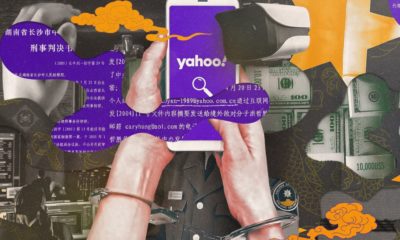Tech
The Download: electric planes, and trans men’s fertility
Published
2 years agoon
By
Drew Simpson
This is today’s edition of The Download, our weekday newsletter that provides a daily dose of what’s going on in the world of technology.
This is what’s keeping electric planes from taking off
What’s happening?: Startups are exploring how electric planes could clean up air travel, which accounts for about 3% of global greenhouse-gas emissions. The reductions from embracing electric flight could be significant—close to 90% fewer emissions for a battery-powered plane charged with renewable energy.
What’s the problem?: Today’s electric aircraft could safely carry you and about a dozen fellow passengers only around 30 miles, according to a recent analysis. The limiting factor is the battery, in particular the amount of energy that can be stored. Today’s batteries don’t have the energy density necessary to power anything but the lightest planes, and even for those, the trip will be about as far as a long bike ride.
What’s next?: Batteries have been packing more power into smaller spaces for about 30 years, and continuing improvements could help electric planes become a more feasible option for flying. But they’re not there yet, and ultimately, the future of electric planes may depend on the future of progress in battery technology. Read the full story.
—Casey Crownhart
A three-parent technique could help trans men have babies
The news: Fertility treatments can be undesirable for transgender men, as they involve pausing gender-affirming hormone therapy and undergoing potentially distressing procedures. New evidence suggests combining two existing techniques for the first time could help sidestep those issues.
How it works: The process involves removing pieces of a transgender man’s ovary, extracting eggs from the ovary in the lab, and swapping in parts of an egg from another person before fertilizing them with sperm to create embryos. Extracting eggs in the lab has helped some people have babies after surviving cancer. And the so-called three-parent technique—using parts of an egg from a third person—has been used in attempts to help people avoid passing genetic disease to their babies and to boost fertility.
Why it matters: The new research suggests that these technologies, used in concert, could also boost a trans man’s chances of using his eggs to create a healthy embryo—and potentially have a baby—without having to undergo typical fertility treatments. Read the full story.
—Jessica Hamzelou
Bright LEDs could spell the end of dark skies
Scientists have known for years that light pollution is growing and can harm both humans and wildlife. In people, increased exposure to light at night disrupts sleep cycles and has been linked to cancer and cardiovascular disease, while wildlife suffers from interruption to their reproductive patterns, increased danger and loss of stealth.
Astronomers, policymakers, and lighting professionals are all working to find ways to reduce light pollution. Many of them advocate installing light-emitting diodes, or LEDs, in outdoor fixtures such as city streetlights, mainly for their ability to direct light to a targeted area. But the high initial investment and durability of modern LEDs mean cities need to get the transition right the first time or potentially face decades of consequences. Read the full story.
—Shel Evergreen
The must-reads
I’ve combed the internet to find you today’s most fun/important/scary/fascinating stories about technology.
1 Google is integrating large language models into robots
In theory, this means they should understand a wider array of commands from humans. (WP $)
+ Google’s robot is powered by their most powerful model. (Wired $)
+ The race to understand the exhilarating, dangerous world of language AI. (MIT Technology Review)
2 Why we can no longer afford to ignore the case for climate adaptation
We’re living in the middle of a cautionary tale. (MIT Technology Review)
+ Extreme heat means we’re going to have to change how we design cities. (The Atlantic $)
3 The US is still doing lots of business with China
Despite escalating tensions, officials are still approving semiconductor and component deals. (WSJ $)
4 How a traumatic brain injury changed how one girl saw the world
Distrusting her senses helped her to forge a new sense of who she is. (Wired $)
+ This is how your brain makes your mind. (MIT Technology Review)
5 This company wants to grow crops in space
Using the first commercial space greenhouse. (Reuters)
+ Why we’re getting closer to discovering what dark matter actually is. (Aeon)
6 Bitcoin’s biggest miners lost more than $1 billion during the crash
They’ve been forced to sell off coins as a result. (Bloomberg $)
+ Alphabet has invested more into blockchain than any other public company. (Cointelegraph)
+ Texas’ power grid is creaking under the strain of crypto mining. (Slate $)
+ The losses from crypto hacks this year are over $1 billion, too. (Reuters)
7 Meet the influencers fighting Kashmir’s internet blackout
Budding influencers are getting creative to skirt around the Indian government’s shutdowns. (Rest of World)
8 Hackers are targeting mining and oil giants
In a new wave of anti-capitalist resistance. (Motherboard)
9 Scientists want to bring the thylacine back from the dead
The wolf-sized marsupial was hunted to extinction a century ago. Now, it could be coming back. (Ars Technica)
+ The same company wants to bring back the wooly mammoth, too. (CNET)
+ How two high school students discovered two new scorpion species. (Slate)
10 Gen Z is turning its back on Amazon
TikTok stars are backing its Labor Union’s demands for higher wages. (WP $)
+ The UK’s youngsters spend more time on TikTok than watching TV. (FT $)
+ If your recently-published book has flopped, flogging it on TikTok could help. (The Guardian)
Quote of the day
“It was not a great night.”
—Ethan Zuckerman, a professor at the University of Massachusetts Amherst, tells the New York Times about the time a series of broken chargers left him stranded and unable to charge his electric car.
The big story
China has started a grand experiment in AI education. It could reshape how the world learns.
August 2021
Zhou Yi was terrible at math. He risked never getting into college. Then a company called Squirrel AI came to his middle school in Hangzhou, China, promising personalized tutoring. He had tried tutoring services before, but this one was different: instead of a human teacher, an AI algorithm would curate his lessons. The 13-year-old decided to give it a try. By the end of the semester, his test scores had risen from 50% to 62.5%. Two years later, he scored an 85% on his final middle school exam.
Experts agree AI will be important in 21st-century education—but how? While academics have puzzled over best practices, China hasn’t waited around. In the last few years, the country’s investment in AI-enabled teaching and learning has exploded. Tech giants, startups, and education incumbents have all jumped in. It’s the world’s biggest experiment on AI in education, and no one can predict the outcome. Read the full story.
—Karen Hao
We can still have nice things
A place for comfort, fun and distraction in these weird times. (Got any ideas? Drop me a line or tweet ’em at me.)
+ Who knew the Prodigy’s Breathe would sound as good as it does acoustic?
+ A teenager tried to hide from police inside a giant teddy bear.
+ Take a deep breath and enjoy this ode to relaxing Twitter accounts.
+ Success looks like different things to different people. Here’s why that’s great.
+ A gigantic inflatable Ozzy Osbourne is touring the US, because why not?
You may like
-


The Download: a microbiome gold rush, and Eric Schmidt’s election misinformation plan
-


The Download: beyond CRISPR, and OpenAI’s superalignment findings
-


The Download: carbon removal concerns, and Yahoo’s China controversy
-


The Download: Yahoo’s misdeeds in China, and AI Act takeaways
-


The Download: the EU AI Act is here, and preventing deadly cancer
-


The Download: inside the first CRISPR treatment, and smarter robots
Tech
The hunter-gatherer groups at the heart of a microbiome gold rush
Published
5 months agoon
12/19/2023By
Drew Simpson
The first step to finding out is to catalogue what microbes we might have lost. To get as close to ancient microbiomes as possible, microbiologists have begun studying multiple Indigenous groups. Two have received the most attention: the Yanomami of the Amazon rainforest and the Hadza, in northern Tanzania.
Researchers have made some startling discoveries already. A study by Sonnenburg and his colleagues, published in July, found that the gut microbiomes of the Hadza appear to include bugs that aren’t seen elsewhere—around 20% of the microbe genomes identified had not been recorded in a global catalogue of over 200,000 such genomes. The researchers found 8.4 million protein families in the guts of the 167 Hadza people they studied. Over half of them had not previously been identified in the human gut.
Plenty of other studies published in the last decade or so have helped build a picture of how the diets and lifestyles of hunter-gatherer societies influence the microbiome, and scientists have speculated on what this means for those living in more industrialized societies. But these revelations have come at a price.
A changing way of life
The Hadza people hunt wild animals and forage for fruit and honey. “We still live the ancient way of life, with arrows and old knives,” says Mangola, who works with the Olanakwe Community Fund to support education and economic projects for the Hadza. Hunters seek out food in the bush, which might include baboons, vervet monkeys, guinea fowl, kudu, porcupines, or dik-dik. Gatherers collect fruits, vegetables, and honey.
Mangola, who has met with multiple scientists over the years and participated in many research projects, has witnessed firsthand the impact of such research on his community. Much of it has been positive. But not all researchers act thoughtfully and ethically, he says, and some have exploited or harmed the community.
One enduring problem, says Mangola, is that scientists have tended to come and study the Hadza without properly explaining their research or their results. They arrive from Europe or the US, accompanied by guides, and collect feces, blood, hair, and other biological samples. Often, the people giving up these samples don’t know what they will be used for, says Mangola. Scientists get their results and publish them without returning to share them. “You tell the world [what you’ve discovered]—why can’t you come back to Tanzania to tell the Hadza?” asks Mangola. “It would bring meaning and excitement to the community,” he says.
Some scientists have talked about the Hadza as if they were living fossils, says Alyssa Crittenden, a nutritional anthropologist and biologist at the University of Nevada in Las Vegas, who has been studying and working with the Hadza for the last two decades.
The Hadza have been described as being “locked in time,” she adds, but characterizations like that don’t reflect reality. She has made many trips to Tanzania and seen for herself how life has changed. Tourists flock to the region. Roads have been built. Charities have helped the Hadza secure land rights. Mangola went abroad for his education: he has a law degree and a master’s from the Indigenous Peoples Law and Policy program at the University of Arizona.
Tech
The Download: a microbiome gold rush, and Eric Schmidt’s election misinformation plan
Published
5 months agoon
12/18/2023By
Drew Simpson
Over the last couple of decades, scientists have come to realize just how important the microbes that crawl all over us are to our health. But some believe our microbiomes are in crisis—casualties of an increasingly sanitized way of life. Disturbances in the collections of microbes we host have been associated with a whole host of diseases, ranging from arthritis to Alzheimer’s.
Some might not be completely gone, though. Scientists believe many might still be hiding inside the intestines of people who don’t live in the polluted, processed environment that most of the rest of us share. They’ve been studying the feces of people like the Yanomami, an Indigenous group in the Amazon, who appear to still have some of the microbes that other people have lost.
But there is a major catch: we don’t know whether those in hunter-gatherer societies really do have “healthier” microbiomes—and if they do, whether the benefits could be shared with others. At the same time, members of the communities being studied are concerned about the risk of what’s called biopiracy—taking natural resources from poorer countries for the benefit of wealthier ones. Read the full story.
—Jessica Hamzelou
Eric Schmidt has a 6-point plan for fighting election misinformation
—by Eric Schmidt, formerly the CEO of Google, and current cofounder of philanthropic initiative Schmidt Futures
The coming year will be one of seismic political shifts. Over 4 billion people will head to the polls in countries including the United States, Taiwan, India, and Indonesia, making 2024 the biggest election year in history.
Tech
Navigating a shifting customer-engagement landscape with generative AI
Published
5 months agoon
12/18/2023By
Drew Simpson
A strategic imperative
Generative AI’s ability to harness customer data in a highly sophisticated manner means enterprises are accelerating plans to invest in and leverage the technology’s capabilities. In a study titled “The Future of Enterprise Data & AI,” Corinium Intelligence and WNS Triange surveyed 100 global C-suite leaders and decision-makers specializing in AI, analytics, and data. Seventy-six percent of the respondents said that their organizations are already using or planning to use generative AI.
According to McKinsey, while generative AI will affect most business functions, “four of them will likely account for 75% of the total annual value it can deliver.” Among these are marketing and sales and customer operations. Yet, despite the technology’s benefits, many leaders are unsure about the right approach to take and mindful of the risks associated with large investments.
Mapping out a generative AI pathway
One of the first challenges organizations need to overcome is senior leadership alignment. “You need the necessary strategy; you need the ability to have the necessary buy-in of people,” says Ayer. “You need to make sure that you’ve got the right use case and business case for each one of them.” In other words, a clearly defined roadmap and precise business objectives are as crucial as understanding whether a process is amenable to the use of generative AI.
The implementation of a generative AI strategy can take time. According to Ayer, business leaders should maintain a realistic perspective on the duration required for formulating a strategy, conduct necessary training across various teams and functions, and identify the areas of value addition. And for any generative AI deployment to work seamlessly, the right data ecosystems must be in place.
Ayer cites WNS Triange’s collaboration with an insurer to create a claims process by leveraging generative AI. Thanks to the new technology, the insurer can immediately assess the severity of a vehicle’s damage from an accident and make a claims recommendation based on the unstructured data provided by the client. “Because this can be immediately assessed by a surveyor and they can reach a recommendation quickly, this instantly improves the insurer’s ability to satisfy their policyholders and reduce the claims processing time,” Ayer explains.
All that, however, would not be possible without data on past claims history, repair costs, transaction data, and other necessary data sets to extract clear value from generative AI analysis. “Be very clear about data sufficiency. Don’t jump into a program where eventually you realize you don’t have the necessary data,” Ayer says.
The benefits of third-party experience
Enterprises are increasingly aware that they must embrace generative AI, but knowing where to begin is another thing. “You start off wanting to make sure you don’t repeat mistakes other people have made,” says Ayer. An external provider can help organizations avoid those mistakes and leverage best practices and frameworks for testing and defining explainability and benchmarks for return on investment (ROI).
Using pre-built solutions by external partners can expedite time to market and increase a generative AI program’s value. These solutions can harness pre-built industry-specific generative AI platforms to accelerate deployment. “Generative AI programs can be extremely complicated,” Ayer points out. “There are a lot of infrastructure requirements, touch points with customers, and internal regulations. Organizations will also have to consider using pre-built solutions to accelerate speed to value. Third-party service providers bring the expertise of having an integrated approach to all these elements.”
